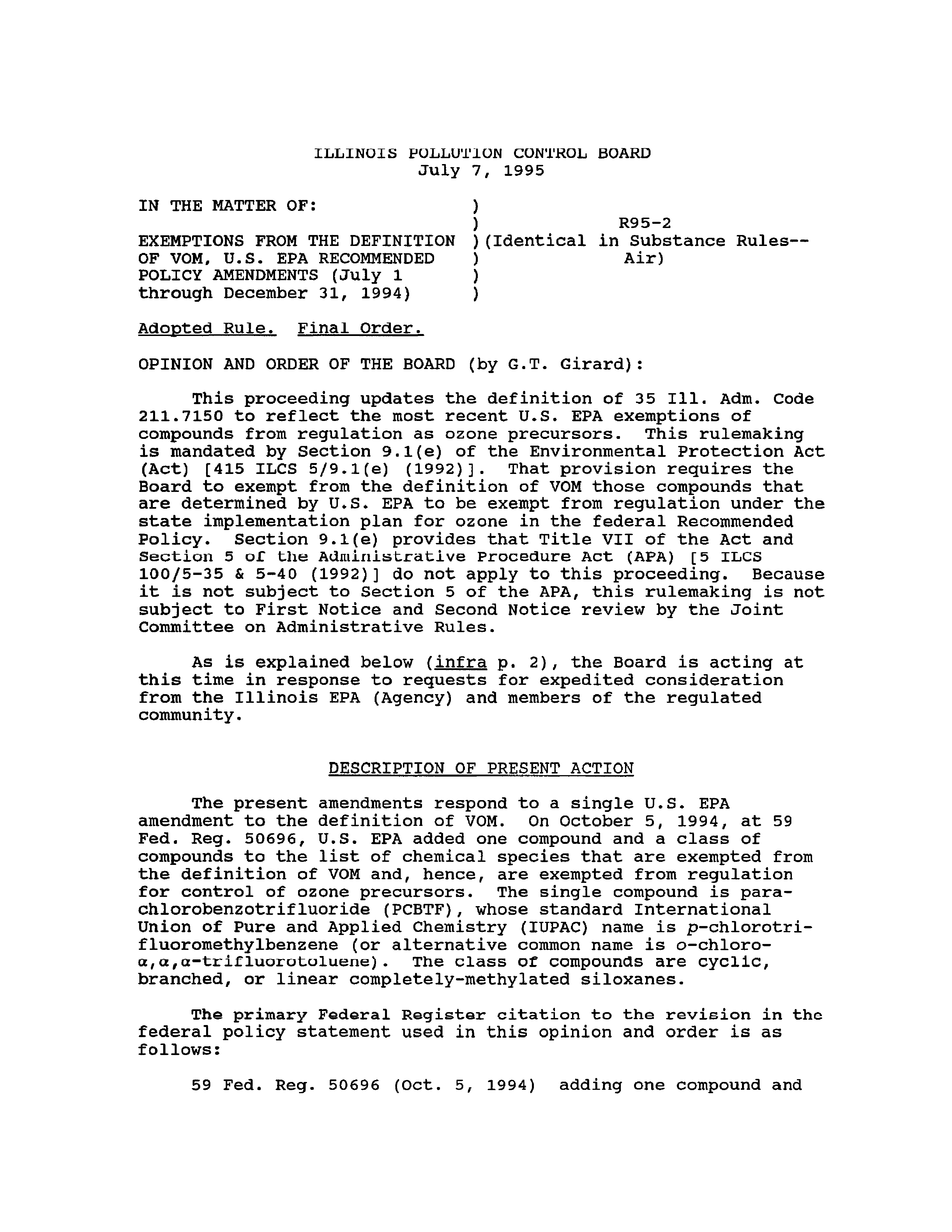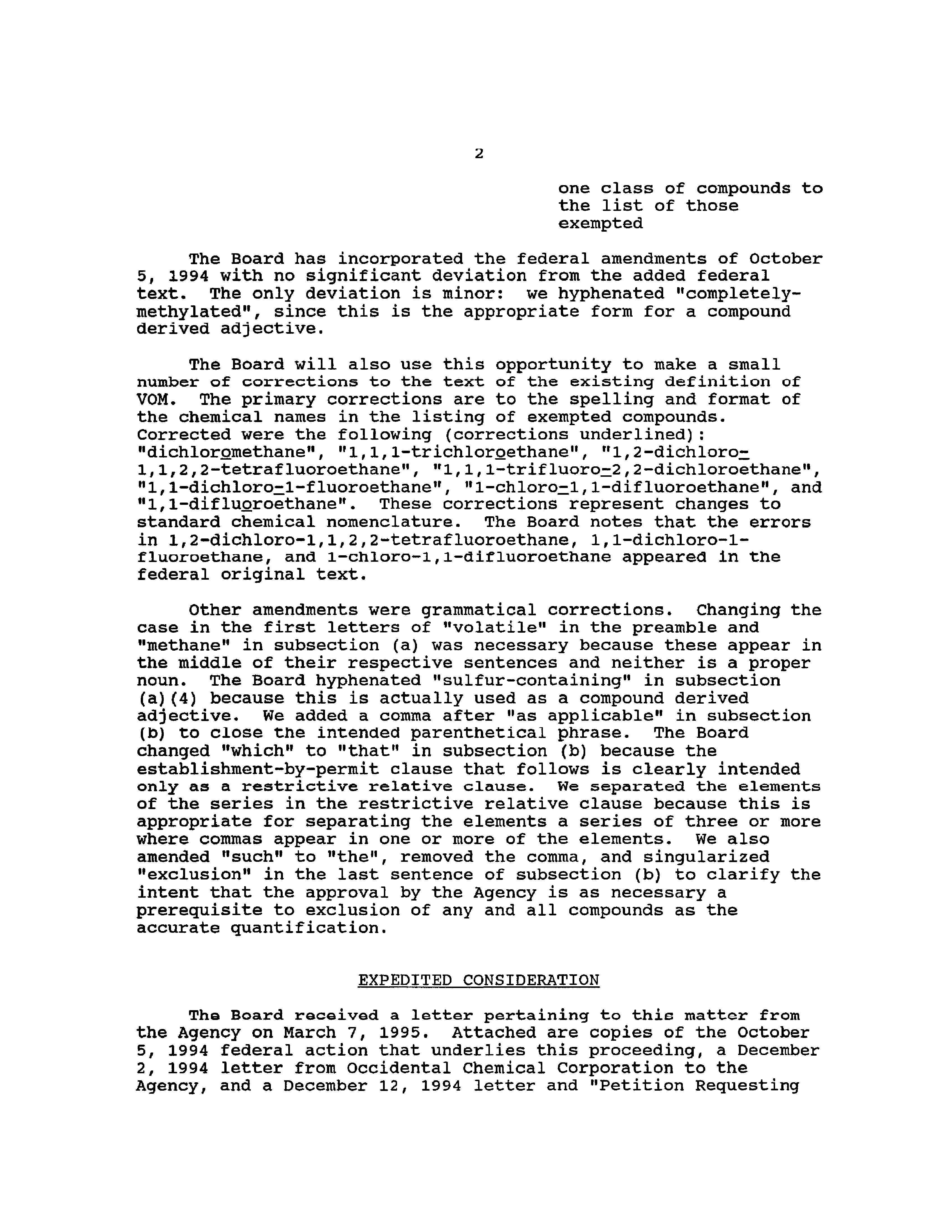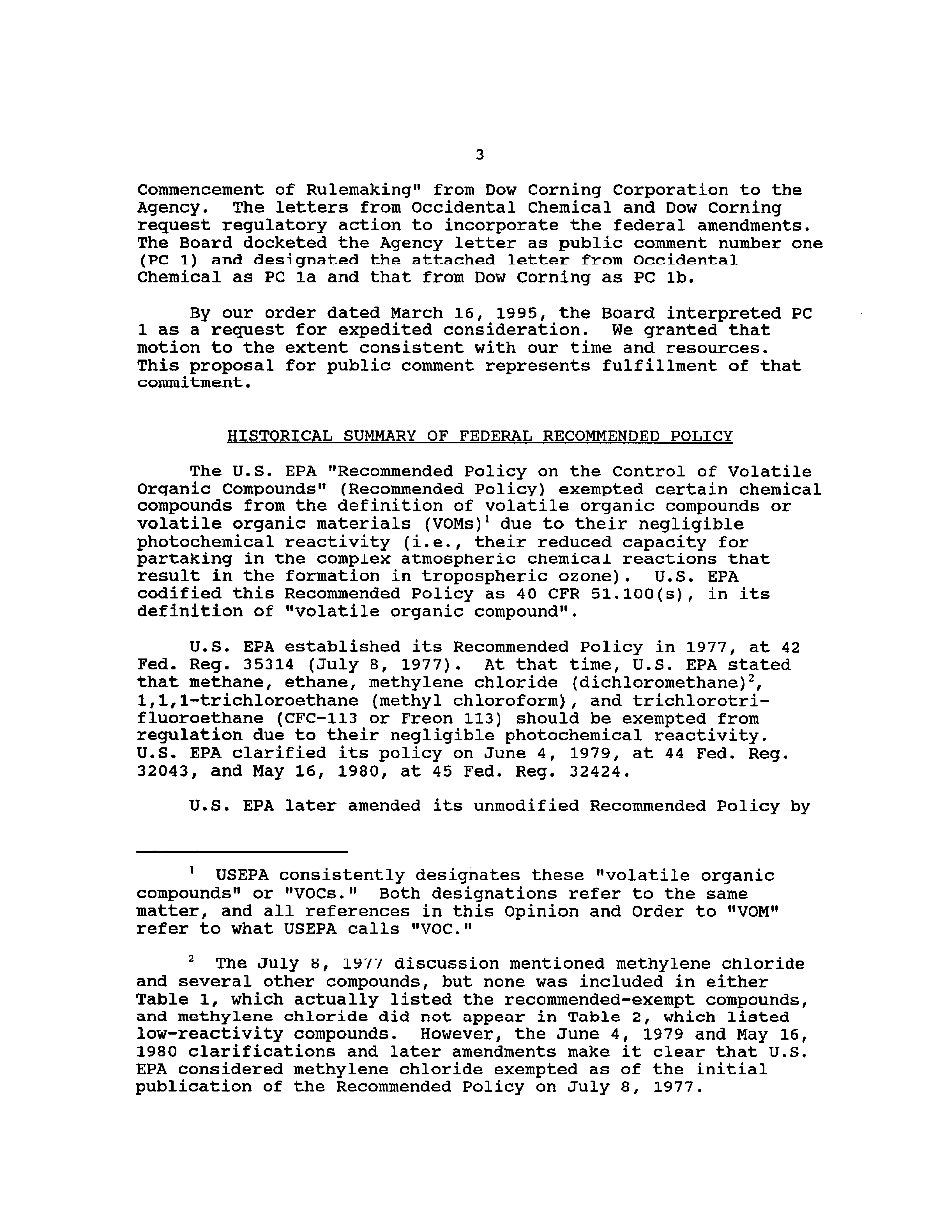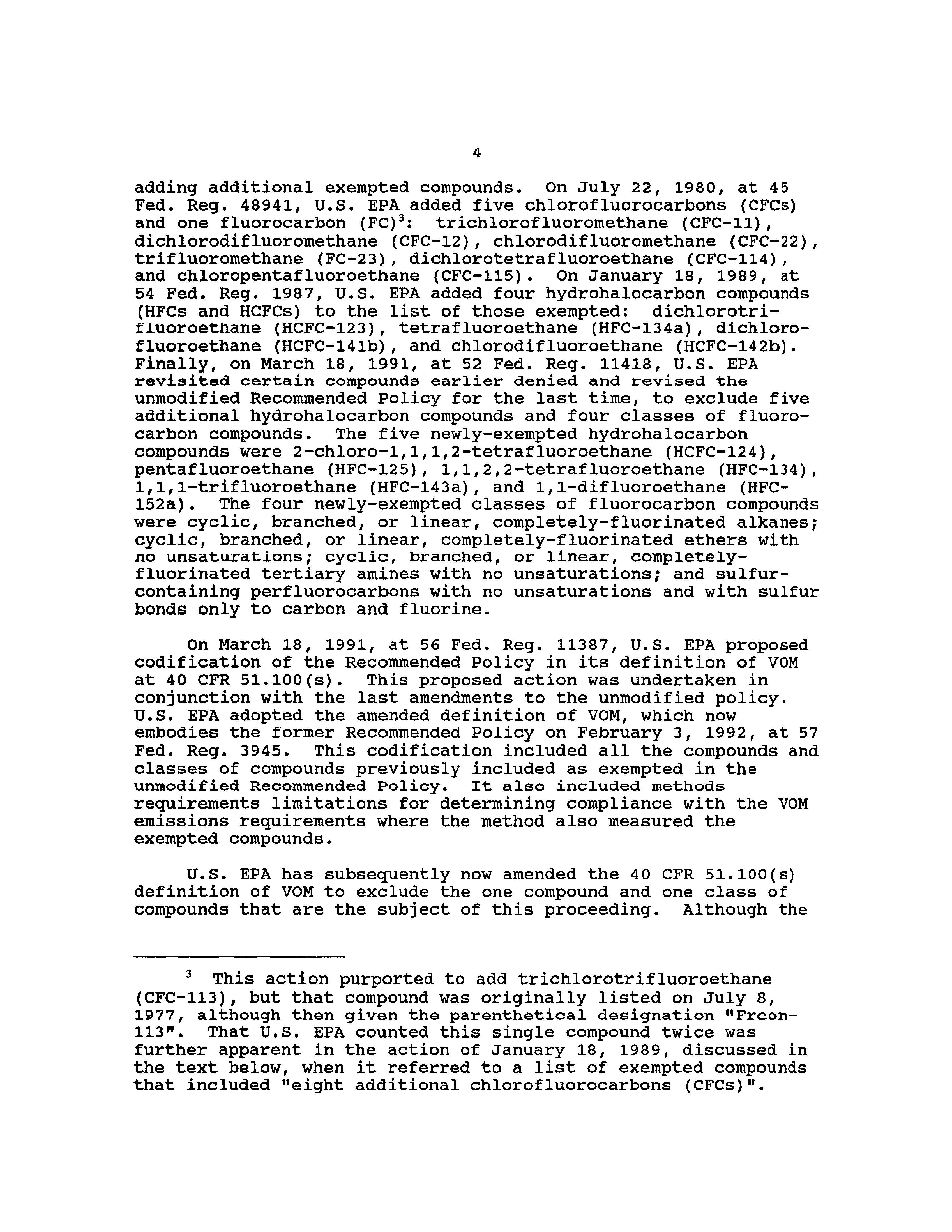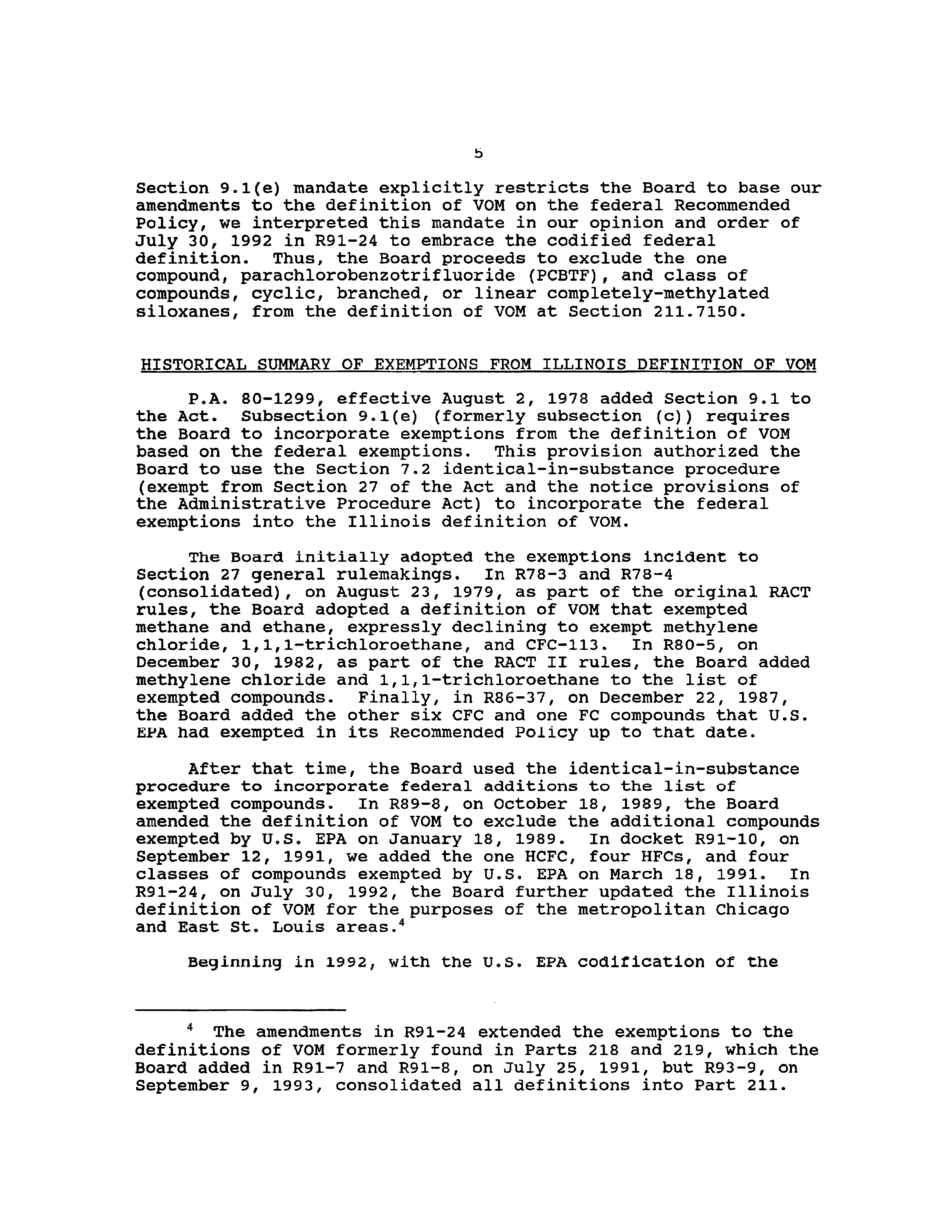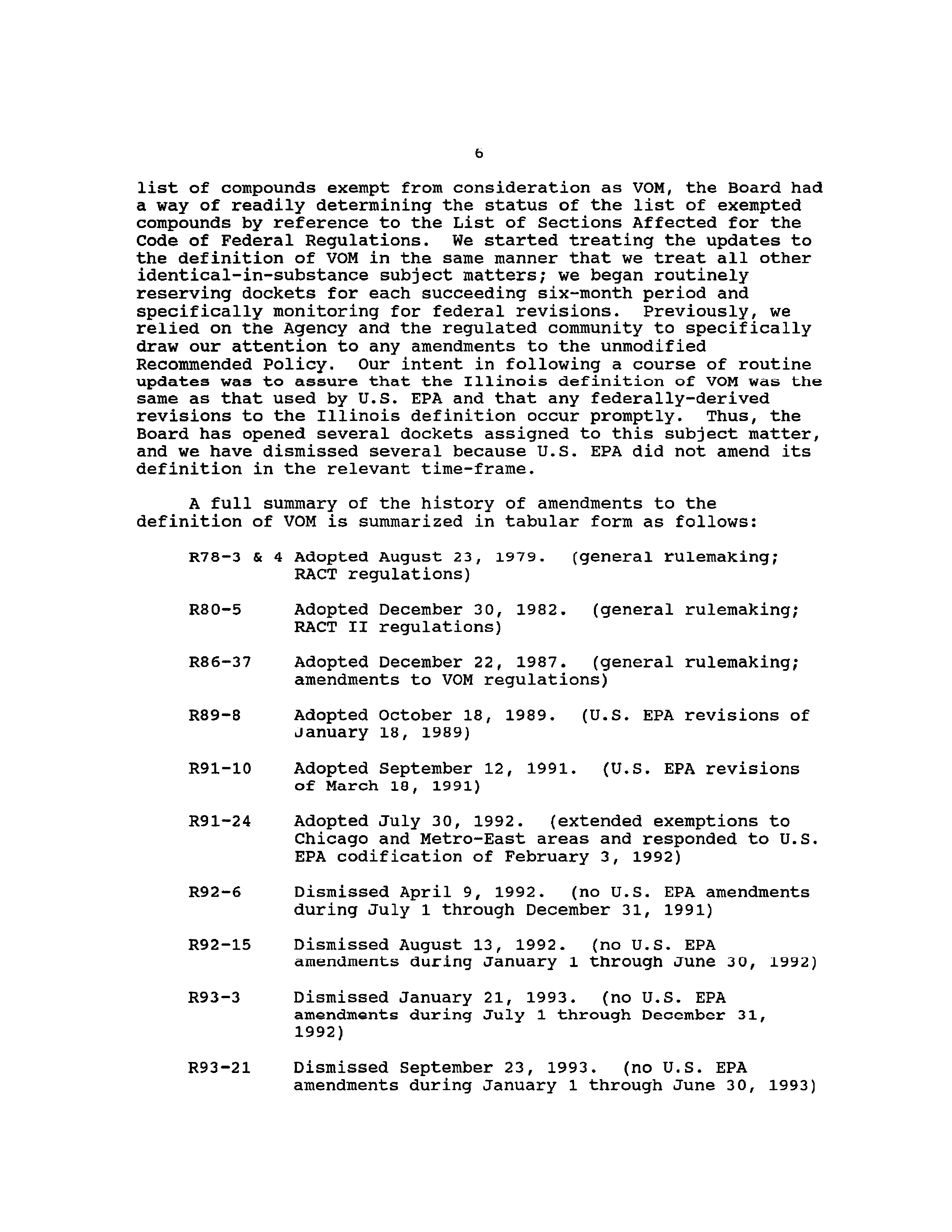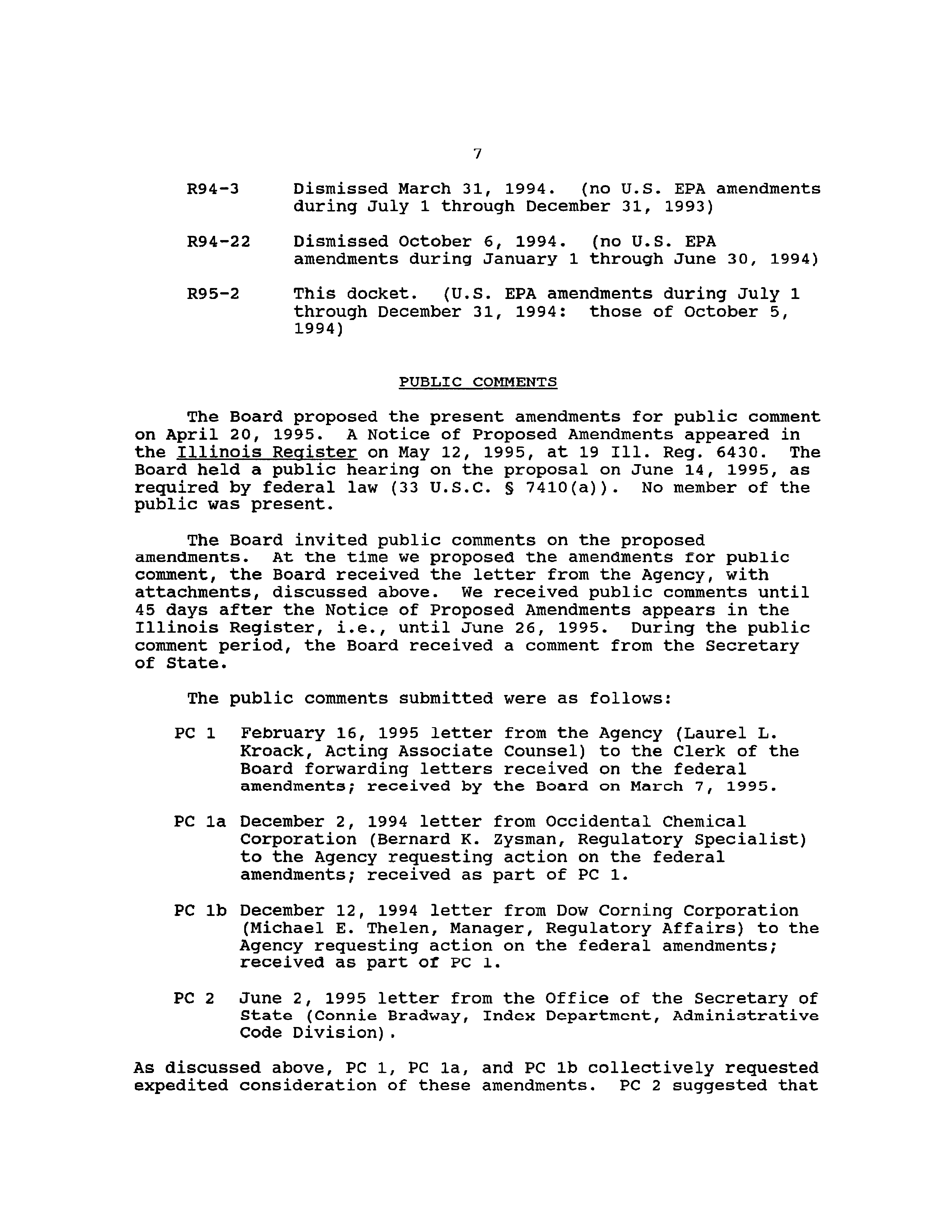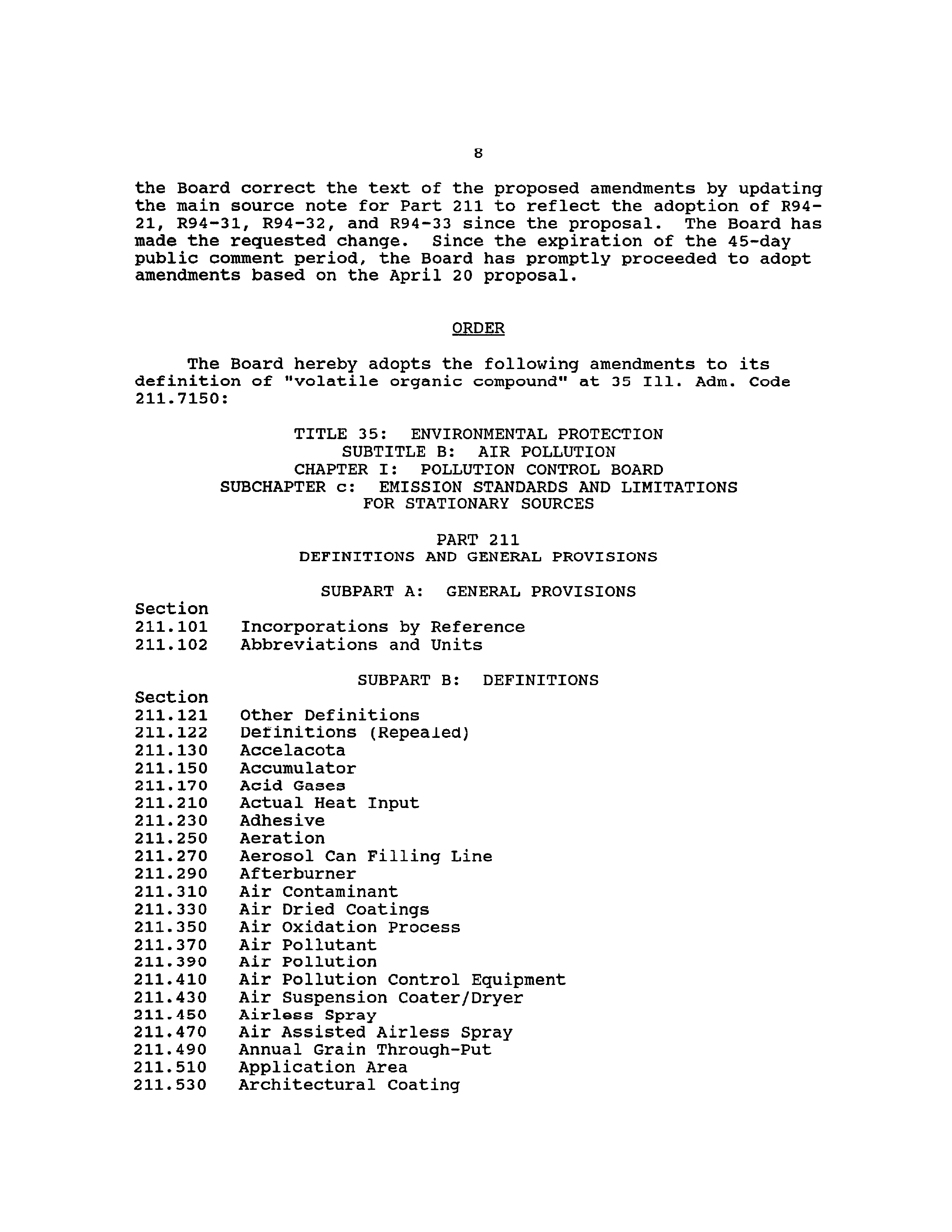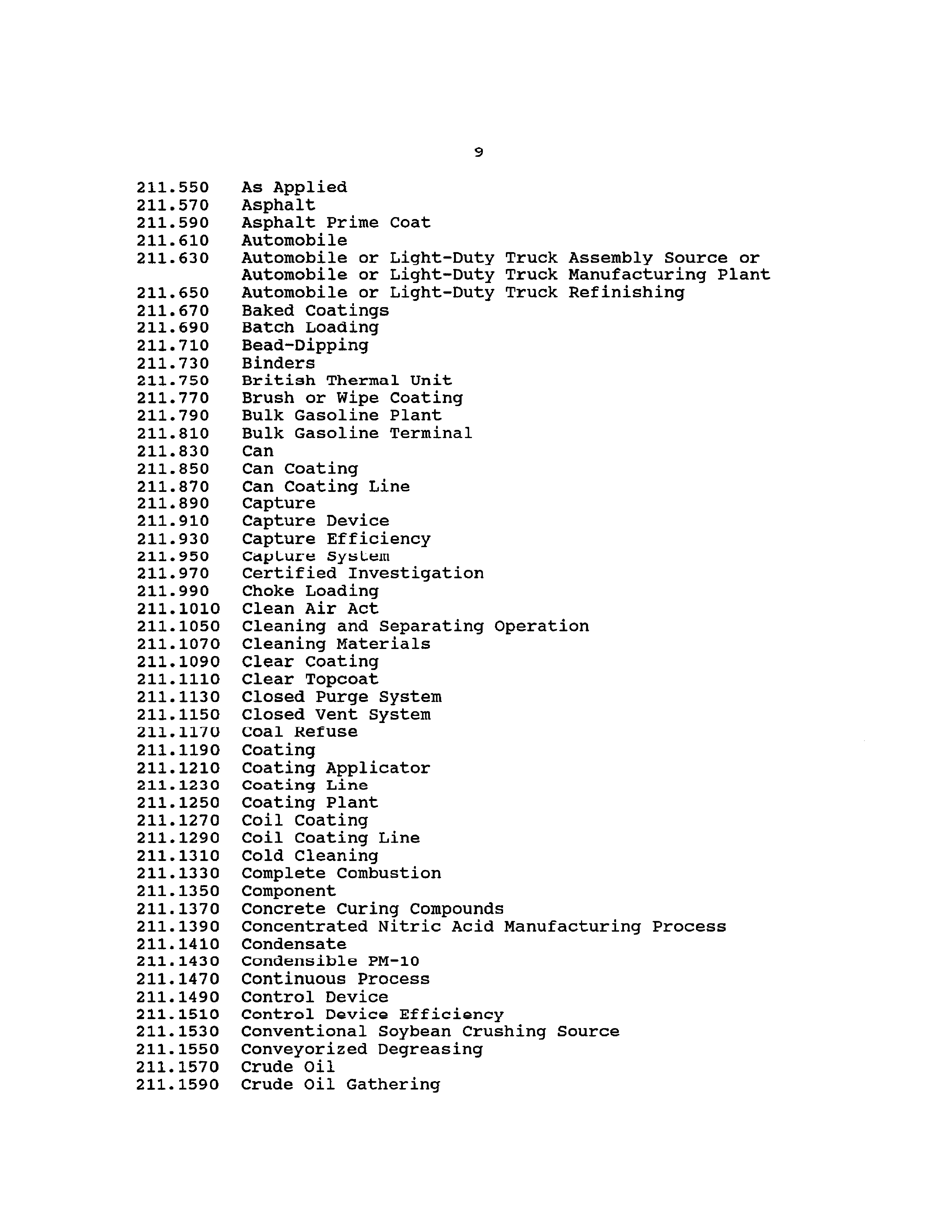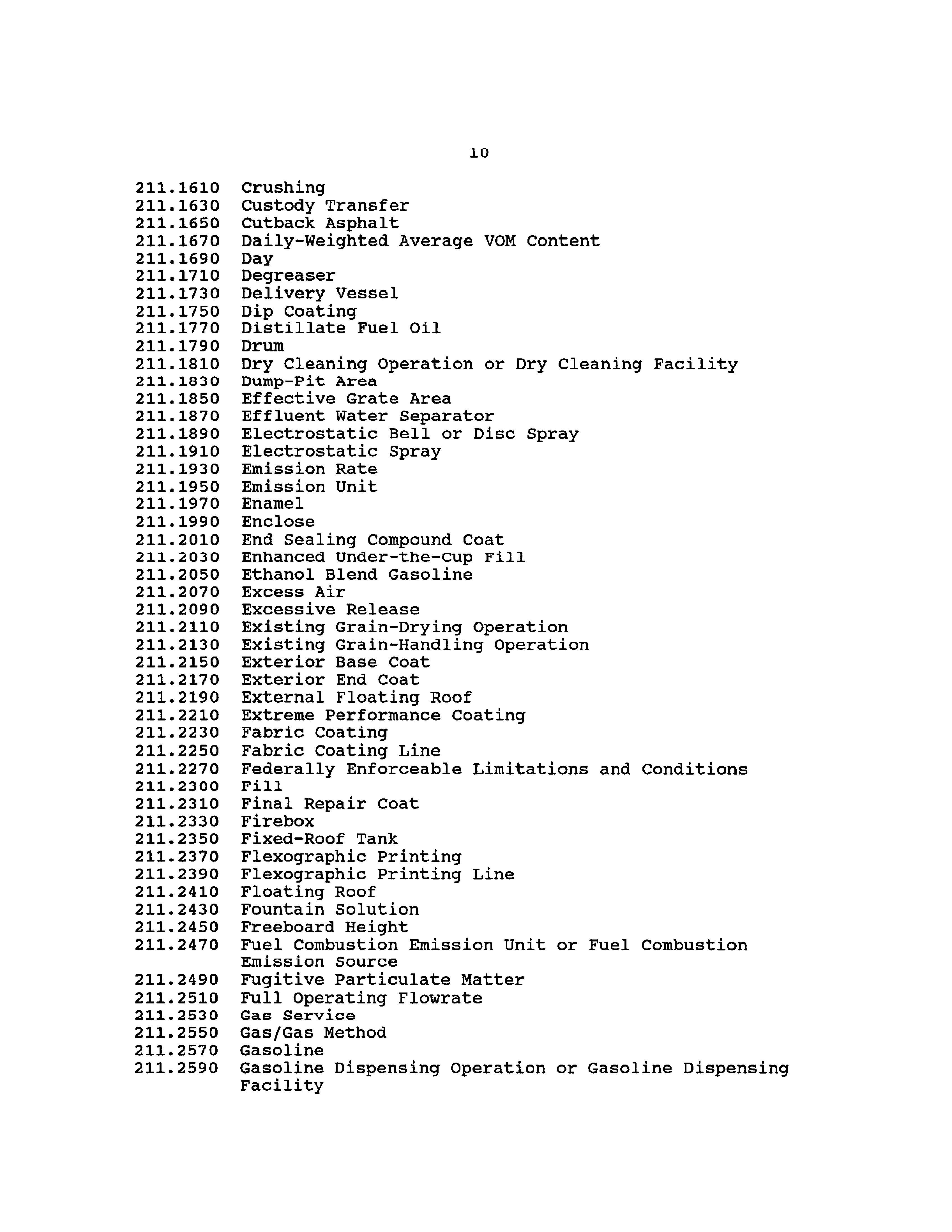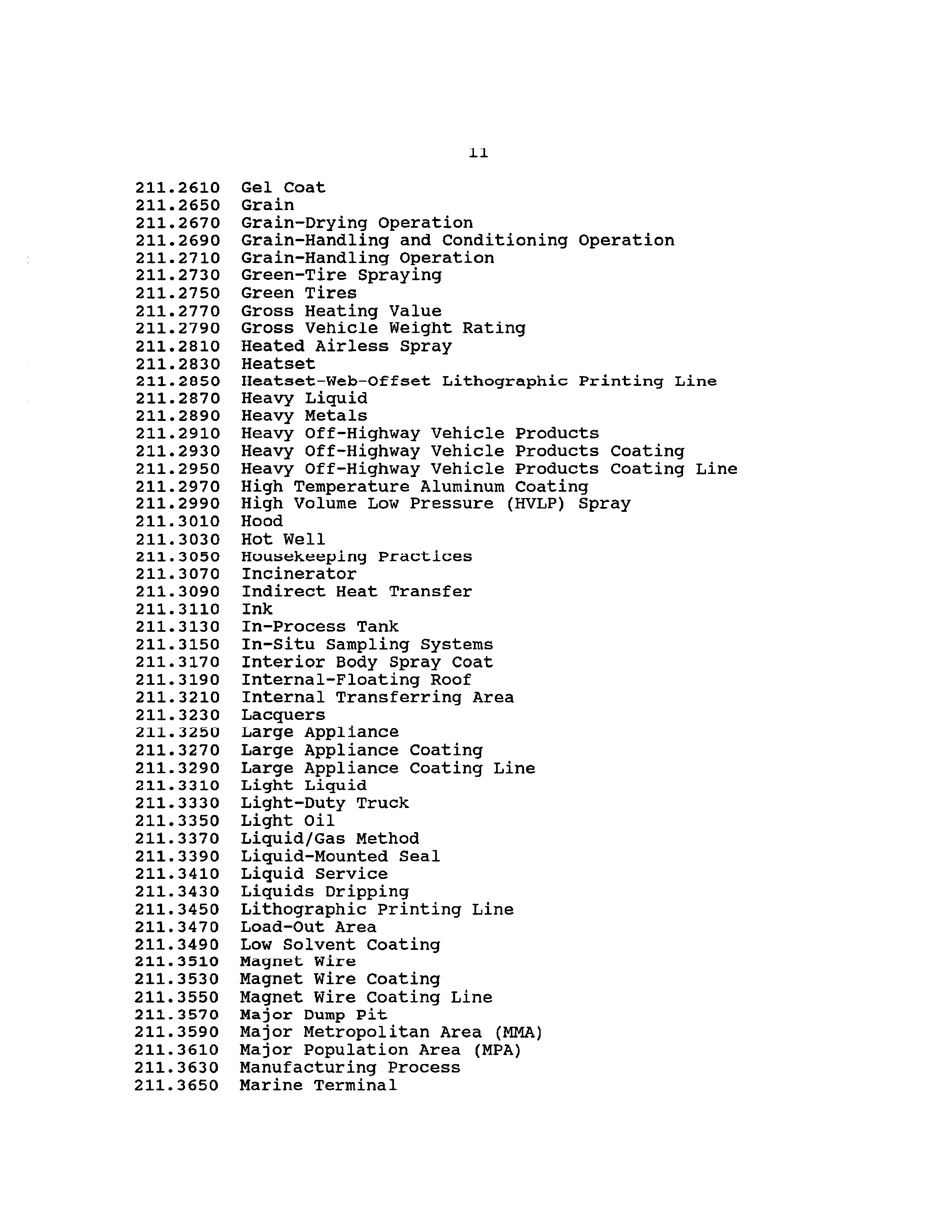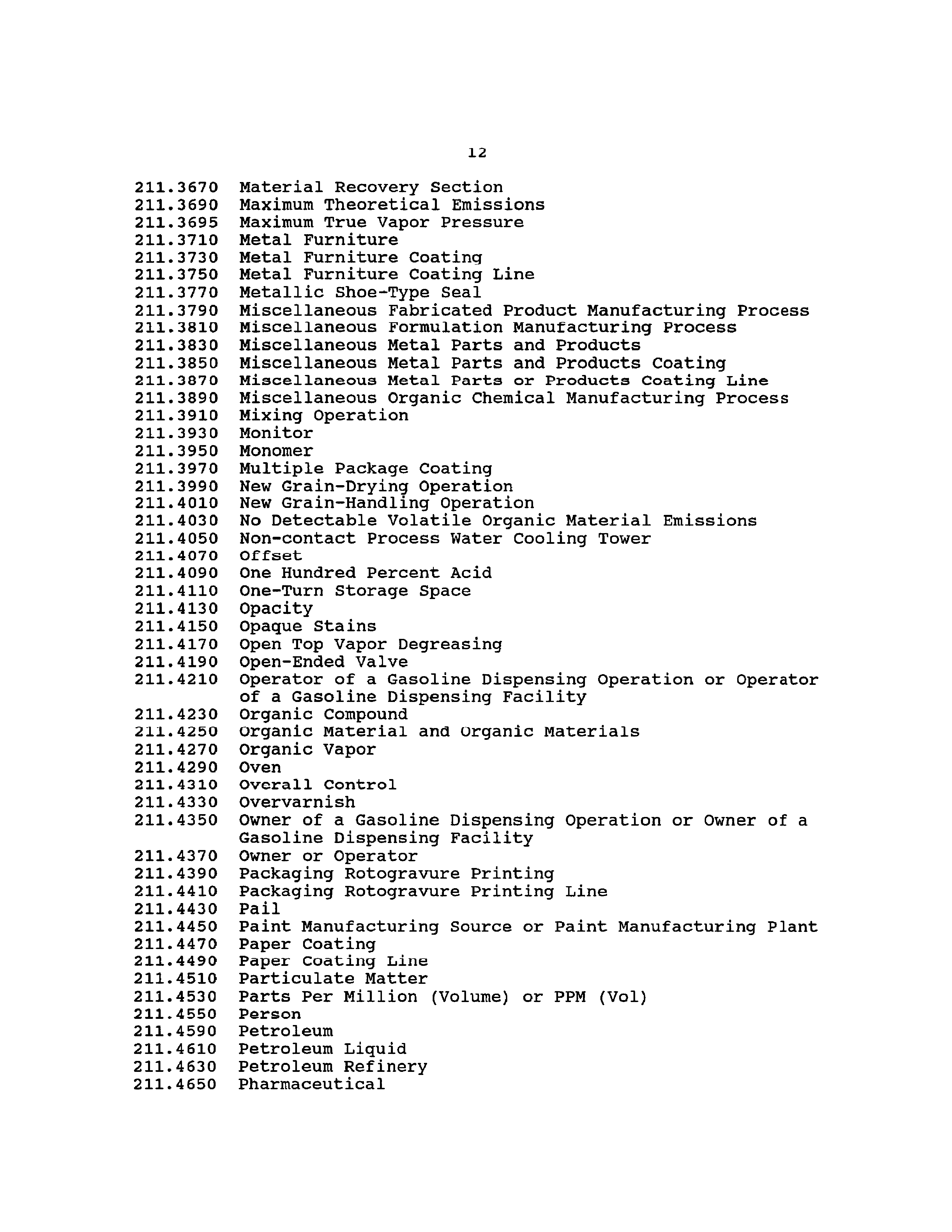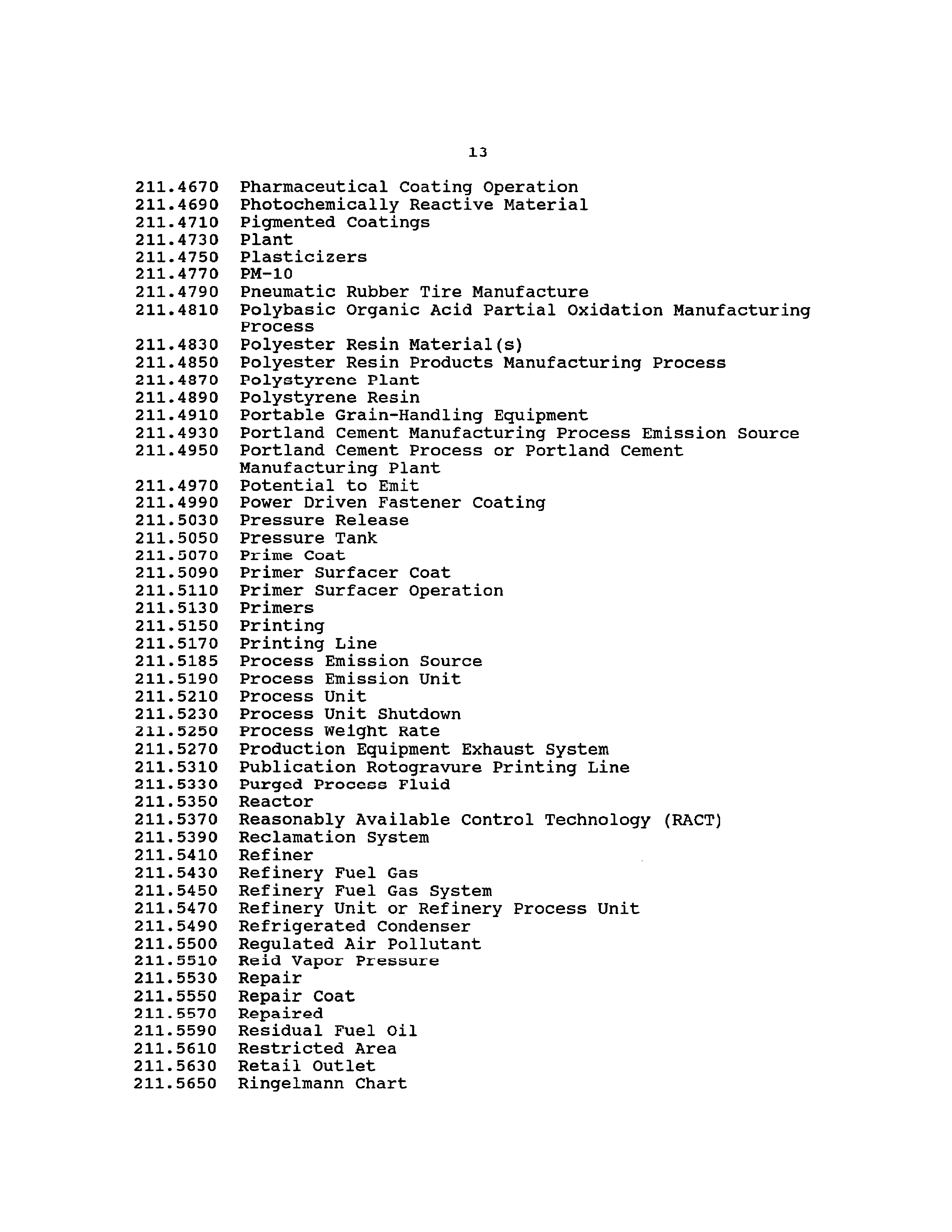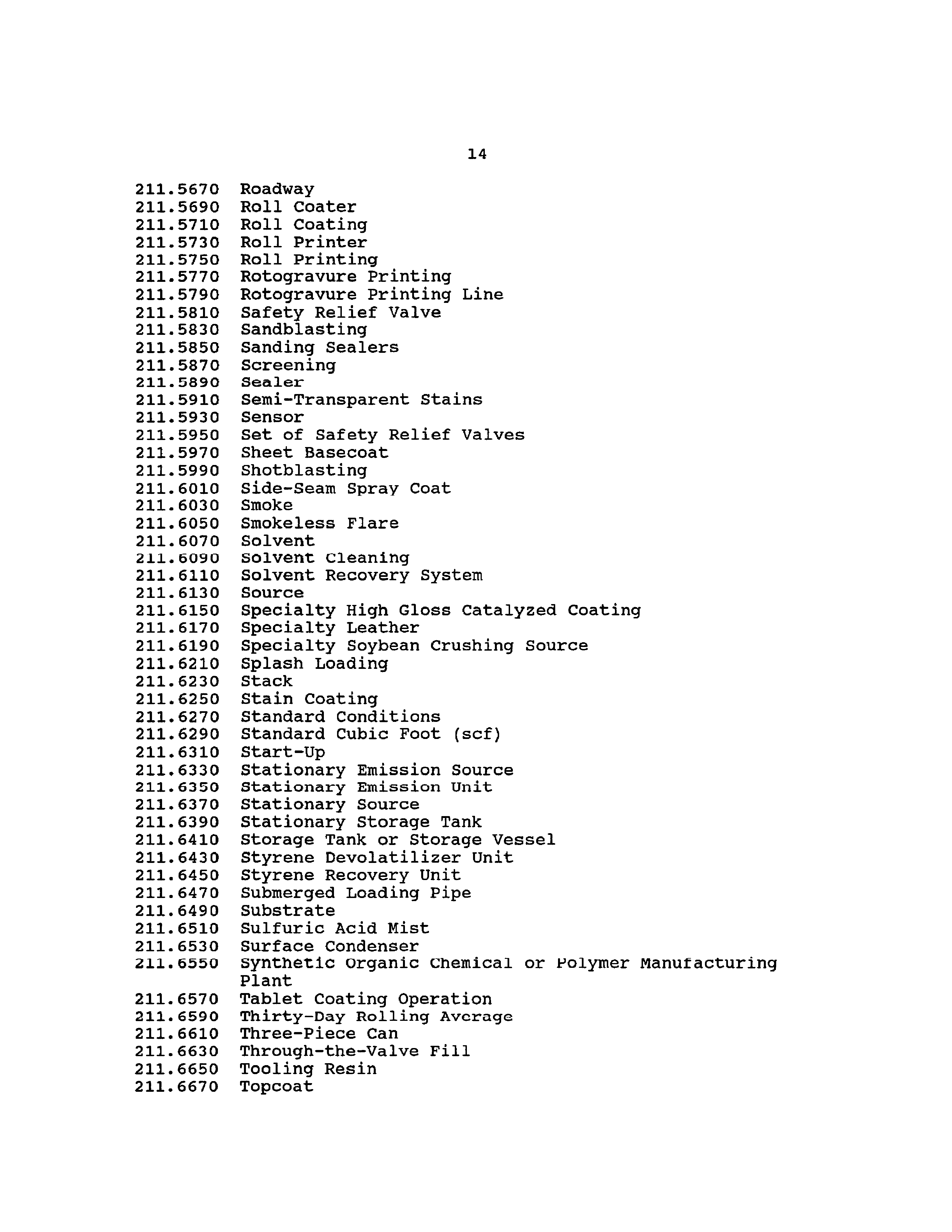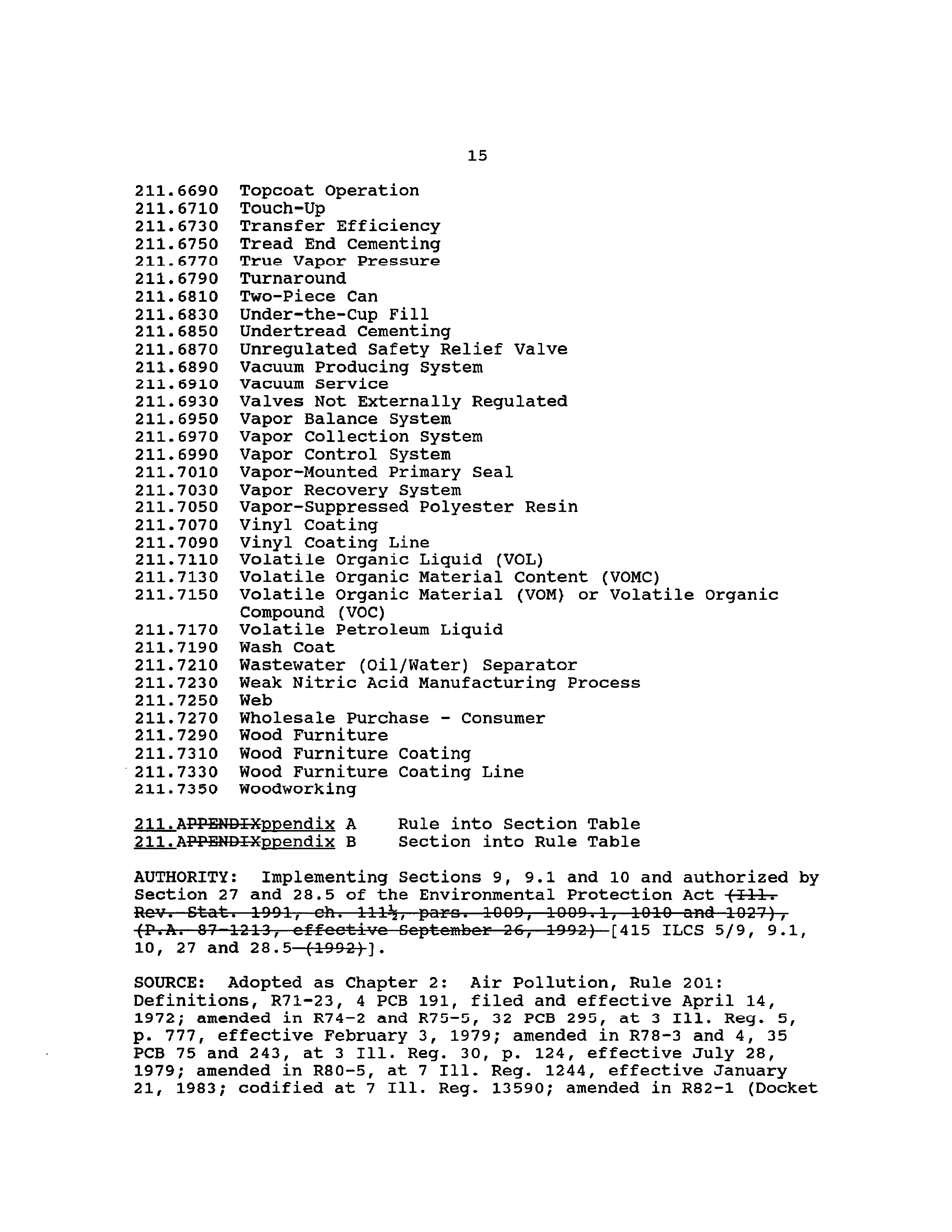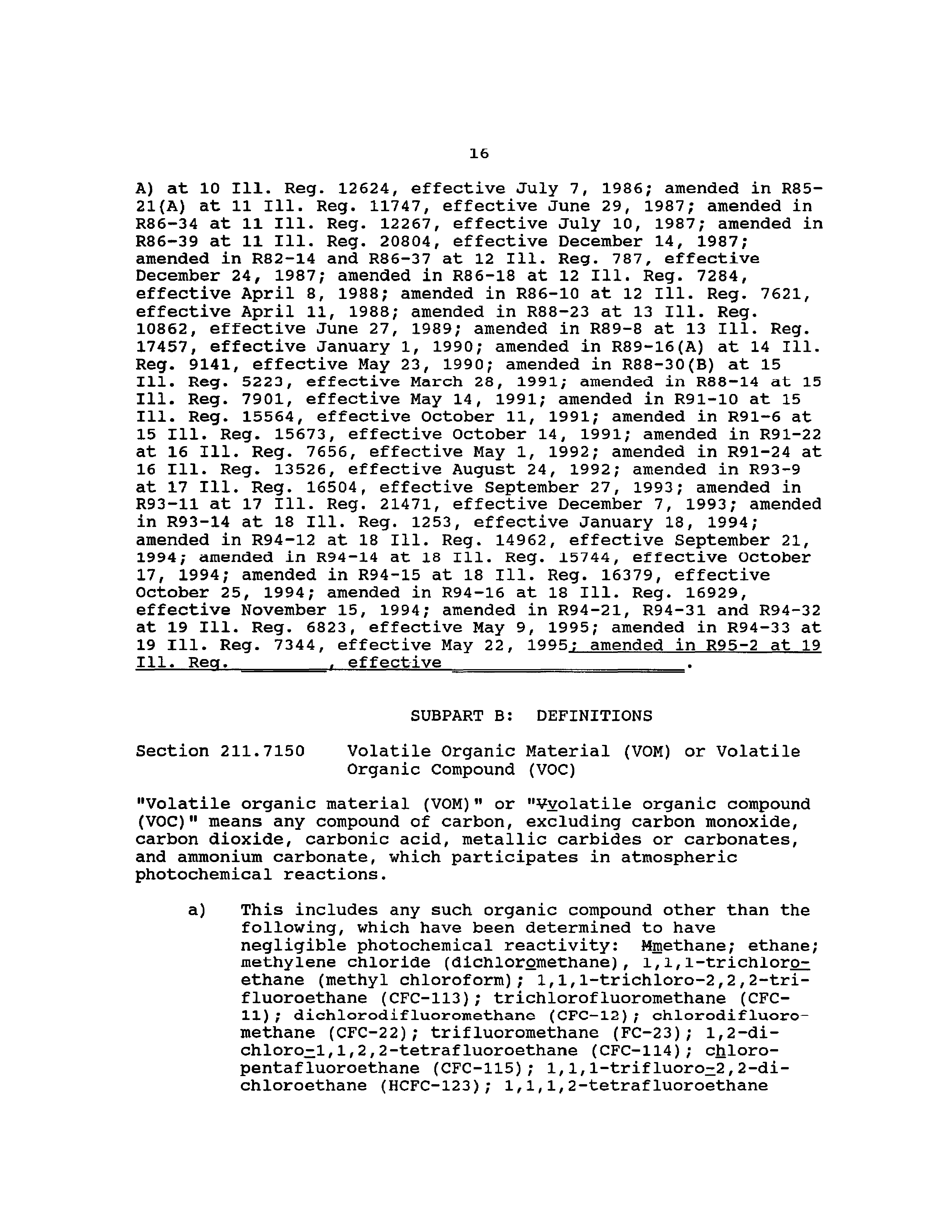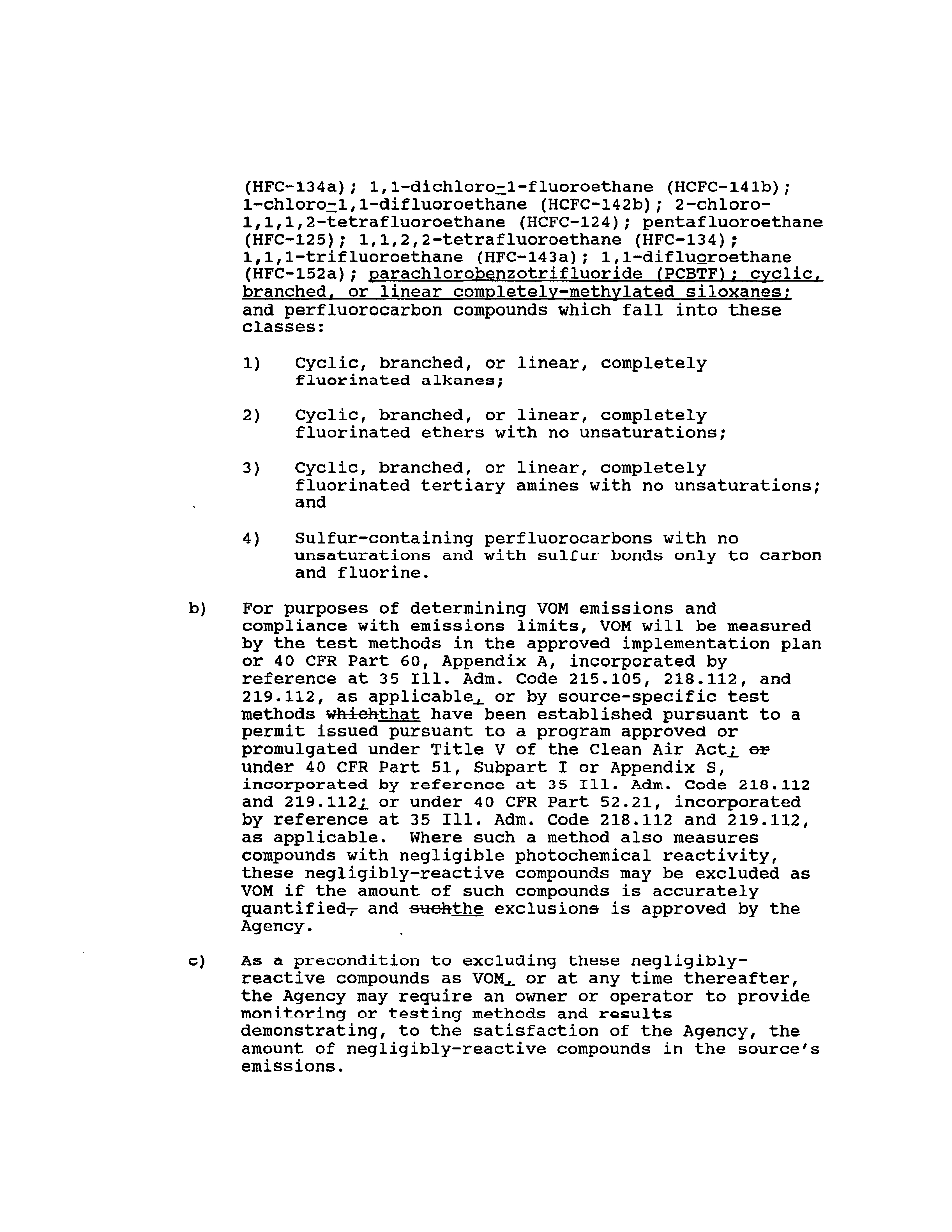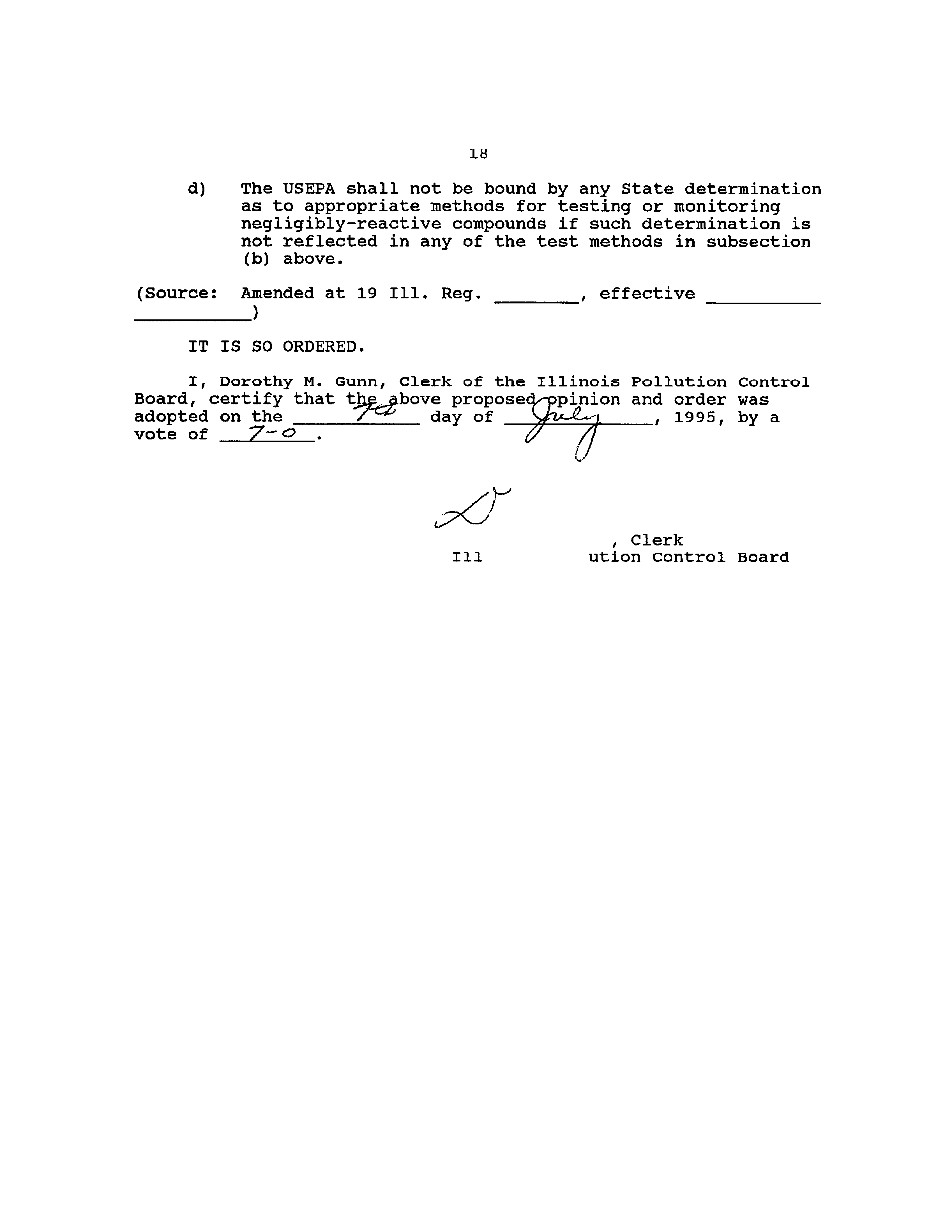ILLINOIS POLLUTiON CONTROL
BOARD
July
7,
1995
IN THE MATTER OF:
)
R95—2
EXEMPTIONS FROM THE DEFINITION
)
(Identical in Substance Rules--
OF VOL
U.S.
EPA RECOMMENDED
)
Air)
POLICY AMENDMENTS
(July
1
)
through December 31,
1994)
)
Adopted Rule.
Final Order.
OPINION
AND ORDER
OF THE BOARD
(by G.T. Girard):
This proceeding updates the definition of 35 Ill. Adm. Code
211.7150 to reflect the most recent U.S. EPA exemptions of
compounds from regulation as ozone precursors.
This rulemaking
is mandated by Section 9.1(e)
of the Environmental Protection Act
(Act)
415
ILCS 5/9.1(e)
(1992).
That provision requires the
Board to exempt from the definition of VOM those compounds that
are determined by U.S. EPA to be exempt from regulation under the
state implementation plan for ozone in the federal Recommended
Policy.
Section 9.1(e) provides that Title VII of the Act and
Section 5 of the Athuinist:.rative Procedure Act
(APA)
5
ILCS
100/5-35 & 5-40
(1992)
do not apply to this proceeding.
Because
it is not subject to Section 5 of the APA, this rulemaking is not
subject to First Notice and Second Notice review by the Joint
Committee on Administrative Rules.
As is explained below
(infra p.
2), the Board is acting at
this time in response to requests for expedited consideration
from the Illinois EPA (Agency) and members of the regulated
community.
DESCRIPTION OF PRESENT ACTION
The present amendments respond to a single U.S. EPA
amendment to the definition of VOM.
On October
5,
1994,
at 59
Fed.
Reg.
50696, U.S. EPA added one compound and a class of
compounds to the list of chemical species that are exempted from
the definition of VOM
arid, hence,
are exempted from regulation
for control of ozone precursors.
The single compound is para—
chlorobenzotrifluoride
(PCBTF), whose standard International
Union of Pure and Applied Chemistry
(IUPAC) name is p-chlorotri-
fluoromethylbenzene
(or alternative common name is o—chloro—
a,a,a—trifluorotuluene).
The class at compounds are cyclic,
branched, or linear completely-methylated siloxanes.
The primary Federal Register citation
to
the revision in the
federal policy statement used in this opinion and order is as
follows:
59 Fed.
Req.
50696
(Oct.
5,
1994)
adding one compound and
2
one class of compounds to
the list of those
exempted
The Board has incorporated the federal amendments of October
5,
1994 with no significant deviation from the added federal
text.
The only deviation is minor:
we hyphenated “completely-
methylated”, since this
is the appropriate form for a compound
derived adjective.
The Board will also use this opportunity to make a small
number
of corrections to
the text of the
existing definition
of
VON.
The primary corrections are to the spelling and format of
the chemical names
in the listing of exempted compounds.
Corrected were the following (corrections underlined):
“dichlorQmethane”,
It1,
1,
l-trichloroethane”,
“1, 2—dichloro-
1, 1,2,2—tetrafluoroethane”,
“1,1, l—trifluoroz2, 2—dichloroethane”,
H1
1—dich1oro~l—f1uoroethane”, “l-chloro=l, 1-difluoroethane”, and
“l,l-difluoroethane”.
These corrections represent changes to
standard chemical nomenclature.
The Board notes that the errors
in l,2—dichloro—1,1,2, 2-tetrafluoroethane,
1,l-dichloro-1-
fluoroethane, and 1—chloro--1,l—ditluoroethane appeared in the
federal original text.
Other amendments were grammatical corrections.
Changing the
case in the first letters of “volatile”
in the preamble and
“methane” in subsection
(a) was necessary because these appear in
the middle of their respective sentences and neither is a proper
noun.
The Board hyphenated “sulfur-containing”
in subsection
(a) (4) because this is actually used as a compound derived
adjective.
We added a comma after “as applicable” in subsection
(b)
to close tne intended parenthetical phrase.
The Board
changed “which” to “that”
in subsection
(b)
because the
establishment-by-permit clause that follows is clearly intended
only as a restrictive relative clause.
We separated the elements
of the series in the restrictive relative clause because this is
appropriate for separating the elements a series of three or more
where commas appear in one or more of the elements.
We also
amended “such” to “the”, removed the comma,
and singularized
“exclusion” in the last sentence of subsection
(b)
to clarify the
intent that the approval by the Agency is as necessary a
prerequisite to exclusion of any and all compounds as the
accurate quantification.
EXPEDITED CONSIDERATION
The Board
received
a letter pertaining to this matter from
the Agency on March
7,
1995.
Attached are copies of the October
5,
1994 federal action that underlies this proceeding,
a December
2,
1994 letter from Occidental Chemical Corporation to the
Agency, and a December 12, 1994 letter and “Petition Requesting
3
Commencement of Rulemaking” from Dow Corning Corporation to the
Agency.
The letters from Occidental Chemical and Dow Corning
request regulatory action to incorporate the federal amendments.
The Board docketed the Agency letter as public comment number one
(PC 1) and designated the attached letter from Occidental
Chemical as PC la and that from Dow Corning as PC lb.
By our order dated March 16,
1995, the Board interpreted PC
1 as a request for expedited consideration.
We granted that
motion to the extent consistent with our time and resources.
This proposal for public comment represents fulfillment of that
commitment.
HISTORICAL SUMMARY OF FEDERAL RECOMMENDED POLICY
The U.S. EPA “Recommended Policy on the Control of Volatile
Orqanic Compounds”
(Recommended Policy) exempted certain chemical
compounds from the definition of volatile organic compounds or
volatile organic materials
(VOM5)’ due to their negligible
photochemical reactivity
(i.e., their reduced capacity for
partaking in the complex atmospheric chemical reactions that
result in the formation in tropospheric ozone).
U.S. EPA
codified this Recommended Policy as 40 CFR 51.100(s),
in its
definition of “volatile organic compound”.
U.S. EPA established its Recommended Policy in 1977,
at
42
Fed.
Reg. 35314
(July
8,
1977).
At that time,
U.S. EPA stated
that methane, ethane, methylene chloride (dichloromethane)
2,
1,1,1-trichloroethane (methyl chloroform), and trichiorotri-
fluoroethane
(CFC-113 or Freon 113)
should be exempted from
regulation due to their negligible photochemical reactivity.
U.S. EPA clarified its policy on June 4,
1979,
at 44 Fed. Reg.
32043, and Nay 16,
1980, at 45 Fed. Reg.
32424.
U.S. EPA later amended its unmodified Recommended Policy by
‘
USEPA consistently designates these “volatile organic
compounds” or “VOCs.”
Both designations refer to the same
matter, and all references in this Opinion and Order to “VON”
refer to what USEPA calls “VOC.”
2
The July 5,
19/7 discussion mentioned methylene chloride
and several other compounds,
but none was included in either
Table
1, which actually listed the recommended-exempt compounds,
and methylene chloride did not appear in Table
2,
which listed
low-reactivity compounds.
However, the June 4,
1979 and May 16,
1980 clarifications and later amendments make it clear that U.S.
EPA considered methylene chloride exempted as of the initial
publication of the Recommended Policy on July 8,
1977.
4
adding additional exempted compounds.
On July 22,
1980,
at
45
Fed. Reg.
48941,
U.S. EPA added five chlorofluorocarbons
(CFCs)
and one fluorocarbon
(FC)3:
trichlorofluoromethane
(CFC-ll),
dichlorodifluoromethane (CFC-l2), chlorodifluoromethane
(CFC—22),
trifluoromethane (FC-23), dichlorotetrafluoroethane
(CFC—114),
and chloropentafluoroethane (CFC—115).
On January 18,
1989,
at
54 Fed.
Reg.
1987, U.S. EPA added four hydrohalocarbon compounds
(HFC5 and HCFC5)
to the list of those exempted:
dichlorotri—
fluoroethane
(HCFC-123), tetrafluoroethane (HFC-134a), dichloro-
fluoroethane
(HCFC-141b),
and chlorodifluoroethane (HCFC—142b).
Finally,
on March
18,
1991, at
52
Fed.
Reg.
11418, U.S. EPA
revisited certain compounds earlier denied and revised the
unmodified Recommended Policy for the last time,
to exclude five
additional hydrohalocarbon compounds and four classes of fluoro-
carbon compounds.
The five newly-exempted hydrohalocarbon
compounds were 2—chloro—1, 1, 1,2-tetrafluoroethane (HCFC-l24),
pentafluoroethane
(HFC-l25),
1,1,2, 2—tetrafluoroethane
(HFC-l34),
1,1,l-trifluoroethane
(HFC-143a), and 1, l-difluoroethane (HFC-
l52a).
The four newly—exempted classes of fluorocarbon compounds
were cyclic,
branched, or linear, completely—fluorinated alkanes;
cyclic, branched,
or linear, completely-fluorinated ethers with
no unsaturatlons;
cyclic,
branched,
or linear, completely—
fluorinated tertiary amines with no unsaturations; and sulfur-
containing perfluorocarbons with no unsaturations and with sulfur
bonds only to carbon and fluorine.
On March 18,
1991,
at 56 Fed. Reg.
11387,
U.S. EPA proposed
codification of the Recommended Policy in its definition of VOM
at 40 CFR 51.100(s).
This proposed action was undertaken in
conjunction with the last amendments to the unmodified policy.
U.S.
EPA adopted the amended definition of VON, which now
embodies the former Recommended Policy on February 3,
1992, at 57
Fed. Reg.
3945.
This codification included all the compounds and
classes of compounds previously included as exempted in the
unmodified Recommended Policy.
It
also included methods
requirements limitations for determining compliance with the VON
emissions requirements where the method also measured the
exempted compounds.
U.S. EPA has subsequently now amended the 40 CFR 51.100(s)
definition of VON to exclude the one compound and one class of
compounds that are the subject of this proceeding.
Although the
~
This action purported to add trichiorotrifluoroethane
(CFC-113),
but that compound was originally listed on July 8,
1977, although then
given the parenthetioal designation “Freon-
113”.
That U.S. EPA counted this single compound twice was
further apparent in the action of January 18,
1989, discussed in
the text below, when it referred to a list of exempted compounds
that included “eight additional chlorofluorocarbons
(CFC5)”.
5
Section 9.1(e) mandate explicitly restricts the Board to base our
amendments to the definition of VON on the federal Recommended
Policy, we interpreted this mandate in our opinion and order of
July 30, 1992 in R9l—24 to embrace the codified federal
definition.
Thus, the Board proceeds to exclude the one
compound, parachlorobenzotrifluoride
(PCBTF), and class of
compounds, cyclic, branched,
or linear completely-methylated
siloxanes,
from the definition of VON at Section 211.7150.
HISTORICAL
SUMMARY
OF EXEMPTIONS FRON ILLINOIS DEFINITION OF VON
P.A.
80—1299, effective August 2,
1978 added Section 9.1 to
the Act.
Subsection 9.1(e)
(formerly subsection
(c)) requires
the Board to incorporate exemptions from the definition of VON
based on the federal exemptions.
This provision authorized the
Board to use the Section 7.2 identical—in—substance procedure
(exempt from Section 27 of the Act and the notice provisions of
the Administrative Procedure Act)
to incorporate the federal
exemptions into the Illinois definition of VON.
The Board initially adopted the exemptions incident to
Section 27 general rulemakings.
In R78-3 and R78-4
(consolidated),
on August 23,
1979,
as part of the original
RACT
rules, the Board adopted a definition of VON that exempted
methane and ethane, expressly declining to exempt methylene
chloride, 1,l,1—trichloroethane, and CFC-1l3.
In R80-5, on
December 30,
1982, as part of the PACT II rules, the Board added
methylene chloride and 1,1,l-trichloroethane to the list of
exempted compounds.
Finally,
in R86-37,
on December 22,
1987,
the Board added the other six CFC and one FC compounds that U.S.
EPA had exempted in its Recommended Policy up to that date.
After that time, the Board used the identical-in-substance
procedure to incorporate federal additions to the list of
exempted compounds.
In R89-8,
on October 18,
1989, the Board
amended the definition of VON to exclude the additional compounds
exempted by U.S.
EPA on January 18,
1989.
In docket R91-lO,
on
September 12,
1991,
we added the one HCFC,
four HFCs, and four
classes of compounds exempted by U.S. EPA on March 18,
1991.
In
R91-24, on July 30,
1992, the Board further updated the Illinois
definition of VON for the purposes of the metropolitan Chicago
and East St. Louis areas.4
Beginning in 1992, with the U.S. EPA codification of the
~‘
The amendments
in R9l-24 extended the exemptions to the
definitions of VON formerly found in Parts 218 and 219, which the
Board added in R9l—7 and R91—8,
on July 25,
1991,
but R93-9, on
September 9,
1993,
consolidated all definitions into Part 211.
6
list of compounds exempt from consideration as VON, the Board had
a way of readily determining the status of the list of exempted
compounds by reference to the List of Sections Affected for the
Code of Federal Regulations.
We started treating the updates to
the definition of VON in the same manner that we treat all other
identical-in-substance subject matters; we began routinely
reserving dockets for each succeeding six-month period and
specifically monitoring for federal revisions.
Previously, we
relied on the Agency and the regulated community to specifically
draw our attention to any amendments
to the unmodified
Recommended Policy.
Our intent in following a course of routine
updates was to assure that the Illinois definition of voN was the
same as that used by U.S. EPA and that any federally-derived
revisions to the Illinois definition occur promptly.
Thus,
the
Board has opened several dockets assigned to this subject matter,
and we have dismissed several because U.S. EPA did not amend its
definition in the relevant time-frame.
A full summary of the history of amendments to the
definition of VON is summarized in tabular form as follows:
R78—3
&
4
Adopted August 23,
1979.
(general rulemaking;
RACT
regulations)
R80—5
Adopted December 30,
1982.
(general rulemaking;
RACT
II regulations)
R86—37
Adopted December 22,
1987.
(general rulemaking;
amendments to VON regulations)
R89—8
Adopted October
18,
1989.
(U.S. EPA revisions of
january 15,
1989)
R91-10
Adopted September 12,
1991.
(U.S. EPA revisions
of March
18,
1991)
1(91—24
Adopted July 30,
1992.
(extended exemptions to
Chicago and Metro—East areas and responded to U.S.
EPA codification of February 3,
1992)
R92—6
Dismissed April
9,
1992.
(no U.S.
EPA amendments
during July
1 through December 31,
1991)
R92—15
Dismissed August 13,
1992.
(no U.S. EPA
amendments during January 1 through dune 30,
1992)
R93—3
Dismissed January
21,
1993.
(no U.S. EPA
amendments during July
1 through December 31,
1992)
R93—21
Dismissed September 23,
1993.
(no U.S. EPA
amendments during January 1 through June 30,
1993)
7
R94-3
Dismissed March 31,
1994.
(no U.S. EPA amendments
during July 1 through December 31,
1993)
R94—22
Dismissed October
6,
1994.
(no U.S. EPA
amendments during January
1 through June 30,
1994)
R95-2
This docket.
(U.S. EPA amendments during July 1
through December 31,
1994:
those of October
5,
1994)
PUBLIC
COMMENTS
The Board proposed the present amendments for public comment
on April 20,
1995.
A Notice of Proposed Amendments appeared in
the Illinois Register on May 12,
1995,
at 19 Ill. Req.
6430.
The
Board held a public hearing on the proposal on June 14,
1995, as
required by federal law (33 U.S.C.
§
7410(a)).
No member of the
public was present.
The Board invited public comments on the proposed
amendments.
At the time we proposed the amendments ror public
comment, the Board received the letter from the Agency, with
attachments, discussed above.
We received public comments until
45 days after the Notice of Proposed Amendments appears in the
Illinois Register,
i.e.,
until June 26,
1995.
During the public
comment period, the Board received a comment from the Secretary
of State.
The public comments submitted were as follows:
PC
1
February 16, 1995 letter from the Agency (Laurel L.
Kroack, Acting Associate Counsel) to the Clerk of the
Board forwarding letters received on the federal
amendments; received by the Board
on
March
7,
1995.
PC la December 2,
1994 letter from Occidental Chemical
Corporation (Bernard K.
Zysman, Regulatory Specialist)
to the Agency requesting action on the federal
amendments; received as part of PC
1.
PC lb December 12,
1994 letter from Dow Corning Corporation
(Michael E.
Thelen, Manager, Regulatory Affairs) to the
Agency requesting action on the federal amendments;
received as part or Pc
1.
PC 2
June 2,
1995 letter from the Office of the Secretary of
State (Connie Bradway, Index Department, Administrative
Code Division).
As discussed above, PC
1, PC
la,
and PC lb collectively requested
expedited consideration of these amendments.
PC
2 suggested that
S
the Board correct the text of the proposed amendments by updating
the main source note for Part 211 to reflect the adoption of R94-
21,
1(94—31, R94—32, and R94—33 since the proposal.
The Board has
made the requested change.
Since the expiration of the 45-day
public comment period, the Board has promptly proceeded to adopt
amendments based on the April 20 proposal.
ORDER
The Board hereby adopts the following amendments to its
definition of “volatile organic compound” at
35 Ill. Adm.
Code
211.7150:
TITLE
35:
ENVIRONMENTAL PROTECTION
SUBTITLE B:
AIR POLLUTION
CHAPTER
I:
POLLUTION CONTROL BOARD
SUBCHAPTER
c:
EMISSION STANDARDS
AND
LIMITATIONS
FOR STATIONARY SOURCES
PART 211
DEFINITIONS
AND GENERAL PROVISIONS
SUBPART A:
GENERAL PROVISIONS
Section
211.101
Incorporations by Reference
211.102
Abbreviations and Units
SUBPART B:
DEFINITIONS
Section
211.121
Other Definitions
211.122
Definitions ~
211. 130
Accelacota
211.150
Accumulator
211.170
Acid
Gases
211.210
Actual Heat Input
211.230
Adhesive
211.250
Aeration
211.270
Aerosol Can Filling Line
211.290
Afterburner
211.310
Air Contaminant
211.330
Air Dried Coatings
211.350
Air Oxidation Process
211.370
Air Pollutant
211.390
Air Pollution
211.410
Air Pollution Control Equipment
211.430
Air Suspension Coater/Dryer
211.450
Airless Spray
211.470
Air Assisted Airless Spray
211.490
Annual Grain Through-Put
211.510
Application Area
211.530
Architectural Coating
9
211.550
211.570
211.590
211.610
211.630
211.650
211.670
211.690
211.710
211.730
211.750
211.770
211.790
211.810
211.830
211.850
211.870
211.890
211.910
211.930
211.950
211.970
211.990
211.1010
211.1050
211.1070
211.1090
211.1110
211.1130
211.1150
211.1170
211.1190
211.1210
211.1230
211.1250
211.1270
211.1290
211.1310
211.1330
211.1350
211. 1370
211.1390
211. 1410
211. 1430
211. 1470
211. 1490
211. 1510
211. 1530
211. 1550
211. 1570
211. 1590
As Applied
Asphalt
Asphalt Prime Coat
Automobile
Automobile or Light-Duty Truck Assembly Source or
Automobile or Light-Duty Truck Manufacturing Plant
Automobile or Light-Duty Truck Refinishing
Baked Coatings
Batch Loading
Bead-Dipping
Binders
British Thermal Unit
Brush or Wipe Coating
Bulk Gasoline Plant
Bulk Gasoline Terminal
Can
Can Coating
Can Coating Line
Capture
Capture Device
Capture Efficiency
CapLure SysLem
Certified Investigation
Choke Loading
Clean Air Act
Cleaning and Separating Operation
Cleaning Materials
Clear Coating
Clear Topcoat
Closed Purge System
Closed Vent System
Coal Refuse
Coating
Coating Applicator
Coating Line
Coating Plant
Coil Coating
Coil Coating Line
Cold Cleaning
Complete Combustion
Component
Concrete Curing Compounds
Concentrated Nitric Acid Manufacturing Process
Condensate
Condensible PM-b
Continuous Process
Control Device
Control DevicQ Efficiency
Conventional Soybean Crushing Source
Conveyorized Degreasing
Crude Oil
Crude Oil Gathering
10
211. 1610
211.1630
211. 1650
211.1670
211.1690
211.1710
211.1730
211.1750
211.1770
211.1790
211.1810
211.1830
211. 1850
211.1870
211.1890
211.1910
211.1930
211.1950
211.1970
211.1990
211.2010
211.2030
211.2050
211.2070
211.2090
211.2110
211.2130
211.2150
211.2170
211.2190
211.2210
211.2230
211.2250
211.2270
211.2300
211.2310
211.2330
211.2350
211.2370
211.2390
211.2410
211.2430
211.2450
211.2470
211.2490
211.2510
211.2530
211.2550
211.2570
211.2590
Crushing
Custody Transfer
Cutback Asphalt
Daily-Weighted Average VOM Content
Day
Degreaser
Delivery Vessel
Dip Coating
Distillate Fuel Oil
Drum
Dry Cleaning Operation or Dry Cleaning Facility
Dump-Pit Area
Effective Grate Area
Effluent Water Separator
Electrostatic Bell or Disc Spray
Electrostatic Spray
Emission Rate
Emission Unit
Enamel
Enclose
End Sealing Compound Coat
Enhanced Under-the—Cup Fill
Ethanol Blend Gasoline
Excess Air
Excessive Release
Existing Grain-Drying Operation
Existing Grain-Handling Operation
Exterior Base Coat
Exterior End Coat
External Floating Roof
Extreme Performance Coating
Fabric Coating
Fabric Coating Line
Federally Enforceable Limitations and Conditions
Fill
Final Repair Coat
Firebox
Fixed-Roof Tank
Flexographic Printing
Flexographic Printing Line
Floating Roof
Fountain Solution
Freeboard Height
Fuel Combustion Emission Unit or Fuel Combustion
Emission Source
Fugitive Particulate Matter
Full Operating Flowrate
Gas Service
Gas/Gas Method
Gasoline
Gasoline Dispensing Operation or Gasoline Dispensing
Facility
11
211.2610
211.2650
211.2670
211.2690
211.2710
211.2730
211.2750
211.2770
211.2790
211.2810
211.2830
211.2050
211.2870
211.2890
211.2910
211.2930
211.2950
211.2970
211.2990
211. 3010
211.3030
211.3050
211.3070
211.3090
211.3110
211.3130
211.3150
211.3170
211. 3190
211. 3210
211.3230
211. 3250
211.3270
211.3290
211.3310
211.3330
211.3350
211.3370
211.3390
211. 3410
211.3430
211.3450
211.3470
211.3490
211.3510
211.3530
211. 3550
211.3570
211.3590
211.3610
211.3630
211.3650
Gel Coat
Grain
Grain—Drying Operation
Grain—Handling and Conditioning Operation
Grain—Handling Operation
Green-Tire Spraying
Green Tires
Gross Heating Value
Gross Vehicle Weight Rating
Heated Airless Spray
Heatset
Heatset—Web--Offset Lithographic
Printing
Line
Heavy
Liquid
Heavy Metals
Heavy Off-Highway Vehicle Products
Heavy Off-Highway Vehicle Products Coating
Heavy Off-Highway Vehicle Products Coating Line
High Temperature Aluminum Coating
High Volume Low Pressure
(HVLP)
Spray
Hood
Hot Well
Housekeepiny Practices
Incinerator
Indirect Heat Transfer
Ink
In—Process Tank
In-Situ Sampling Systems
Interior Body Spray Coat
Internal-Floating Roof
Internal Transferring Area
Lacquers
Large Appliance
Large Appliance Coating
Large Appliance Coating Line
Light Liquid
Light-Duty Truck
Light Oil
Liquid/Gas Method
Liquid-Mounted Seal
Liquid Service
Liquids Dripping
Lithographic Printing Line
Load-Out Area
Low Solvent Coating
Magnet Wire
Magnet Wire Coating
Magnet Wire Coating Line
Major Dump Pit
Major Metropolitan Area
(MMA)
Major Population Area
(MPA)
Manufacturing Process
Marine Terminal
12
211.3670
211.3690
211.3695
211.3710
211.3730
211.3750
211.3770
211.3790
211.3810
211.3830
211.3850
211.3870
211.3890
211.3910
211.3930
211.3950
211.3970
211.3990
211.4010
211.4030
211.4050
211.4070
211.4090
211.4110
211. 4130
211.4150
211.4170
211.4190
211.4210
211.4230
211.4250
211.4270
211.4290
211.4310
211.4330
211.4350
211.4370
211.4390
211.4410
211.4430
211.4450
211.4470
211.4490
211.4510
211.4530
211.4550
211.4590
211.4610
211.4630
211.4650
Material Recovery Section
Maximum Theoretical Emissions
Maximum True Vapor Pressure
Metal Furniture
Metal Furniture Coating
Metal Furniture Coating Line
Metallic Shoe-Type Seal
Miscellaneous Fabricated Product Manufacturing Process
Miscellaneous Formulation Manutacturing Process
Miscellaneous Metal Parts and Products
Miscellaneous Metal Parts and Products Coating
Miscellaneous Metal Parts or Products Coating Line
Miscellaneous
Organic
Chemical
Manufacturing
Process
Mixing Operation
Monitor
Monomer
Multiple Package Coating
New Grain-Drying Operation
New Grain-Handling Operation
No Detectable Volatile Organic Material Emissions
Non-contact Process Water Cooling Tower
Offset
One Hundred Percent Acid
One—Turn Storage Space
Opacity
Opaque
Stains
Open Top Vapor Degreasing
Open-Ended Valve
Operator of a Gasoline Dispensing Operation or Operator
of
a Gasoline Dispensing Facility
Organic Compound
organic Material and organic Materials
Organic Vapor
Oven
Overall Control
Overvarnish
Owner of a Gasoline Dispensing Operation or Owner of a
Gasoline Dispensing Facility
Owner or Operator
Packaging Rotogravure Printing
Packaging Rotogravure Printing Line
Pail
Paint Manufacturing Source or Paint Manufacturing Plant
Paper Coating
Paper
coating
Line
Particulate
Matter
Parts
Per
Million
(Volume)
or
PPM
(Vol)
Person
Petroleum
Petroleum
Liquid
Petroleum Refinery
Pharmaceutical
13
211.4670
211.4690
211.4710
211.4730
211.4750
211.4770
211.4790
211.4810
211.4830
211.4850
211.4870
211.4890
211.4910
211.4930
211.4950
211.4970
211.4990
211.5030
211.5050
211.5070
211.5090
211.5110
211.5130
211.5150
211.5170
211.5185
211.5190
211.5210
211.5230
211.5250
211.5270
211.5310
211.5330
211.5350
211.5370
211.5390
211.5410
211.5430
211.5450
211.5470
211.5490
211.5500
211.5510
211.5530
211.5550
211. 5570
211.5590
211.5610
211.5630
211.5650
Pharmaceutical Coating Operation
Photochemically Reactive Material
Pigmented Coatings
Plant
Plasticizers
PM-tO
Pneumatic Rubber Tire Manufacture
Polybasic Organic Acid Partial Oxidation Manufacturing
Process
Polyester Resin Material(s)
Polyester Resin Products Manufacturing Process
Polystyrene Plant
Polystyrene Resin
Portable Grain-Handling Equipment
Portland Cement Manufacturing Process Emission Source
Portland Cement Process or Portland Cement
Manufacturing
Plant
Potential
to
Emit
Power Driven Fastener Coating
Pressure Release
Pressure Tank
Prime Coat
Primer Surfacer Coat
Primer Surfacer Operation
Primers
Printing
Printing Line
Process Emission Source
Process Emission Unit
Process Unit
Process Unit Shutdown
Process weight Rate
Production Equipment Exhaust System
Publication Rotogravure Printing Line
Purged Prooess Fluid
Reactor
Reasonably Available Control Technology
(RACT)
Reclamation System
Refiner
Refinery Fuel Gas
Refinery Fuel Gas System
Refinery Unit or Refinery Process Unit
Refrigerated Condenser
Regulated Air Pollutant
Reid
Vapor
Pressure
Repair
Repair
Coat
Repaired
Residual
Fuel
Oil
Restricted
Area
Retail
Outlet
Ringelmann
Chart
14
211.5670
211.5690
211.5710
211.5730
211.5750
211.5770
211.5790
211.5810
211.5830
211.5850
211.5870
211.5890
211.5910
211.5930
211.5950
211.5970
211.5990
211. 6010
211.6030
211. 6050
211.6070
211.6090
211.6110
211.6130
211.6150
211. 6170
211.6190
211.6210
211.6230
211.6250
211.6270
211.6290
211.6310
211.6330
211.6350
211.6370
211.6390
211.6410
211.6430
211.6450
211.6470
211.6490
211.6510
211.6530
211.6550
211.6570
211. 6590
211. 6610
211.6630
211.6650
211.6670
Roadway
Roll Coater
Roll Coating
Roll Printer
Roll Printing
Rotogravure
Printing
Rotogravure Printing Line
Safety Relief Valve
Sandblasting
Sanding Sealers
Screening
Sealer
Semi-Transparent Stains
Sensor
Set of Safety Relief Valves
Sheet Basecoat
Shotbiasting
Side-Seam
Spray
Coat
Smoke
Smokeless Flare
Solvent
solvent cleaning
Solvent Recovery System
Source
Specialty High Gloss Catalyzed Coating
Specialty Leather
Specialty Soybean Crushing Source
Splash Loading
Stack
Stain Coating
Standard
Conditions
Standard
Cubic
Foot
(scf)
Start-Up
Stationary Emission Source
Stationary Emission Unit
Stationary Source
Stationary Storage Tank
Storage Tank or Storage Vessel
Styrene Devolatilizer Unit
Styrene Recovery Unit
Submerged
Loading
Pipe
Substrate
Sulfuric
Acid
Mist
Surface Condenser
synthetic organic chemical or Polymer Manutacturing
Plant
Tablet Coating Operation
Thirty-Day Rolling Average
Three-Piece Can
Through-the-Valve Fill
Tooling Resin
Topcoat
15
Topcoat Operation
Touch-Up
Transfer Efficiency
Tread End Cementing
True Vapor Pressure
Turnaround
Two—Piece Can
Under-the-Cup Fill
Undertread Cementing
Unregulated Safety Relief Valve
Vacuum Producing System
Vacuum Service
Valves Not Externally Regulated
Vapor Balance System
Vapor Collection System
Vapor Control System
Vapor—Mounted Primary Seal
Vapor Recovery System
Vapor—Suppressed Polyester Resin
Vinyl Coating
Vinyl Coating Line
Volatile Organic Liquid
(VOL)
Volatile Organic Material Content
(VOMC)
Volatile Organic Material
(VOM)
or Volatile Organic
Compound
(VOC)
Volatile Petroleum Liquid
Wash Coat
Wastewater (Oil/Water)
Separator
Weak Nitric Acid Manufacturing Process
Web
Wholesale
Purchase
—
Consumer
Wood
Furniture
Wood
Furniture
Coating
Wood
Furniture
Coating
Line
Woodworking
AUTHORITY:
Implementing
Sections
9,
9.1
and
10
and
authorized
by
Section
27
and
28.5
of
the
Environmental
Protection Act (Ill.
ReV.
Stat.
1991,
ch.
11l-½,
paro.
1009,
1009.1,
1010 and 1027),
(P.A.
87—1213, cffcotive September~26, 1-992)
£415 ILCS 5/9,
9.1,
10,
27 and 28.5
(1992).
SOURCE:
Adopted as Chapter
2:
Air Pollution,
Rule 201:
Definitions, R71—23,
4 PCB 191,
filed and effective April 14,
1972; amended
in R74—2 and R75—5,
32 PCB 295,
at
3
Ill. Reg.
5,
p. 777, effective February 3,
1979;
amended in R78—3 and 4,
35
PCB 75 and 243,
at
3 Ill. Reg.
30,
p.
124, effective July 28,
1979; amended in R80-5,
at
7 Ill. Reg.
1244,
effective January
21,
1983; codified at 7 Ill.
Reg. 13590; amended in R82—1
(Docket
211.6690
211.6710
211.6730
211.6750
211.
6770
211.
6790
211.
6810
211.6830
211.
6850
211.6870
211.
6890
211. 6910
211.6930
211. 6950
211. 6970
211.6990
211.7010
211.7030
211.7050
211.7070
211.7090
211.7110
211.7130
211.7150
211.7170
211.7190
211.7210
211.7230
211.7250
211.7270
211.7290
211.7310
• 211.7330
211.7350
211.APPENDIXppendix A
211.APPENDIXppendix B
Rule
into
Section
Table
Section
into
Rule
Table
16
A)
at 10 Ill.
Reg. 12624, effective July
7,
1986; amended in R85—
21(A)
at 11 Ill. Reg.
11747, effective June 29,
1987; amended in
R86—34 at 11 Ill.
Peg.
12267, effective July 10,
1987;
amended in
P86—39 at 11 Ill.
Reg.
20804, effective December 14,
1987;
amended in R82—14 and P86—37 at
12 Ill. Peg.
787, effective
December 24,
1987;
amended in R86—18 at 12 Ill. Reg.
7284,
effective April
8,
1988;
amended in R86-1O at
12 Ill.
Reg.
7621,
effective April 11,
1988; amended in R88—23 at 13 Ill. Reg.
10862, effective June 27,
1989; amended in R89—8 at 13 Ill.
Peg.
17457, effective January
1,
1990; amended in R89-l6(A) at 14
Ill.
Reg.
9141, effective May 23,
1990; amended in P88-30(B) at 15
Ill. Reg.
5223,
effective March
28,
1991;
amended in R88—14 at 15
Ill. Reg.
7901,
effective May 14,
1991;
amended in P91-10 at 15
Ill. Reg.
15564, effective October 11,
1991; amended in P91—6 at
15 Ill. Reg.
15673, effective October 14,
1991; amended in P91-22
at 16 111.
Reg.
7656,
effective May 1,
1992;
amended in R91—24 at
16 Ill.
Reg. 13526,
effective August 24,
1992; amended in P93-9
at 17 Ill. Peg.
16504, effective September 27,
1993;
amended in
R93—11 at 17 Ill.
Reg.
21471, effective December 7,
1993; amended
in P93—14 at 18
Ill.
Reg.
1253, effective January 18,
1994;
amended in P94—12 at
18
Ill.
Peg.
14962, effective September
21,
1994; amended in R94—l4 at 18 Ill. Reg.
15744, effective October
17,
1994; amended in R94-15 at 18 Ill. Reg.
16379, effective
October 25,
1994;
amended in P94—16 at 18 Ill.
Reg.
16929,
effective November 15,
1994;
amended in P94-21, R94-31 and R94-32
at 19 Ill.
Reg.
6823,
effective May
9,
1995;
amended in P94—33 at
19 Ill. Peg.
7344,
effective May 22, 1995~amended in R95-2
at 19
Ill.
Req.
,
effective
SUBPART B:
DEFINITIONS
Section 211.7150
Volatile Organic Material
(VON)
or Volatile
Organic Compound
(VOC)
“Volatile organic material (VON)” or “Vyolatile organic compound
(VOC)” means any compound of carbon,
excluding carbon monoxide,
carbon dioxide, carbonic acid, metallic carbides or carbonates,
and ammonium carbonate,
which participates in atmospheric
photochemical reactions.
a)
This includes any such organic compound other than the
following, which have been determined to have
negligible photochemical reactivity:
M~ethane;ethane;
methylene chloride
(dichlorQmethane),
1,1, l-trichlorg1
ethane
(methyl chloroform);
1,1, 1-trichloro-2,2,2-tn-
fluoroethane
(CFC-113); trichlorofluoromethane (CFC-
11); dichlorodifluoromethane (CFC-12); chiorodifluoro-
methane
(CFC-22); trifluoromethane
(FC—23); l,2—di-
chlorol,1,2,2-tetrafluoroethane (CFC-114); chloro-
pentafluoroethane
(CFC-115);
1,1,1-tnifluoro-2,2di
chloroethane
(HCFC-123);
1,1, 1, 2-tetrafluoroethane
(HFC-134a);
1, 1-dichloro-1-fluoroethane
(HCFC-141b);
l—chloro~1,1-dif1uoroethane(HCFC-142b); 2—chloro-
1,1,1, 2-tetnafluoroethane (HCFC-124); pentafluonoethane
(HFC-125);
1,1,2,2-tetnafluonoethane (HFC—134);
1, 1,1—tnifluoroethane (HFC—143a);
1, 1—difluonoethane
(HFC-152a); parachlorobenzotnifluonide
(PCBTF~i;cyclic.
branched,
on linear coinpletelv—methylated siloxanes
and perfluorocarbon compounds which fall into these
classes:
1)
Cyclic, branched,
or linear, completely
fluorinated alkanes;
2)
Cyclic, branched,
or linear, completely
fluorinated ethers with no unsaturations;
3)
Cyclic, branched,
or linear, completely
fluorinated
tertiary
amines
with
no
unsaturations;
and
4)
Sulfur-containing perfluorocarbons with no
unsaturations
and
with
sulfur
bonds
only
to
carbon
and
fluorine.
b)
For purposes of determining VON emissions and
compliance with emissions limits, VON will be measured
by the test methods in the approved implementation plan
or 40 CFP Part
60, Appendix A,
incorporated by
reference at 35 Ill. Adm. Code 215.105, 218.112, and
219.112, as applicable~or by source-specific test
methods whichthat have been established pursuant to a
permit issued pursuant to a program approved or
promulgated under Title V of the Clean Air Act~er
under 40 CFP Part 51, Subpart
I or Appendix 5,
incorporated by reference at 35 Ill. Adm.
code 218.112
and 219.112j~or under 40 CFR Part 52.21, incorporated
by reference at 35 Ill. Adm.
Code 218.112 and 219.112,
as applicable.
Where such a method also measures
compounds with negligible photochemical reactivity,
these negligibly—reactive compounds may be excluded as
VON if the amount of such compounds
is accurately
quantified7 and sucht~ exclusions is approved by the
Agency.
c)
As
a
precondition
to
excluding
these
negligibly—
reactive compounds as VONJ, or at any time thereafter,
the Agency may require an owner or operator to provide
monitoring
or
testing
methods and results
demonstrating, to the satisfaction of the Agency, the
amount of negligibly—reactive compounds in the source’s
emissions.
18
d)
The USEPA shall not be bound by any State determination
as to appropriate methods for testing or monitoring
negligibly-reactive compounds if such determination is
not reflected in any of the test methods in subsection
(b) above.
(Source:
Amended at 19 Ill. Peg.
effective
__________
____________________________
)
IT IS SO ORDERED.
I, Dorothy N.
Gunn,
Clerk of the Illinois Pollution Control
Board, certify that tJ~jbovepropose4--ppinion and order was
adopted on the
/7•
day of
\,hz-Z~-j
,
1995,
by a
voteof
7—c
.
6’
7
I-
Clerk
ution
Control
Board
Ill
